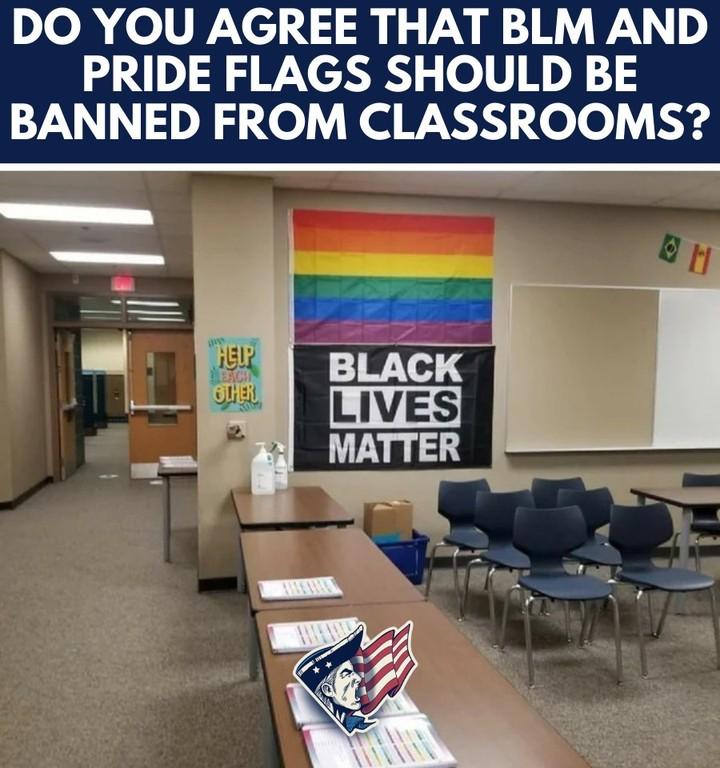
A single image showing a classroom wall adorned with two symbols—the Black Lives Matter flag and the Pride rainbow flag—has reignited a fierce national debate. The caption beneath it reads: “Do you agree that BLM and Pride flags should be banned from classrooms?” This question echoes a larger controversy unfolding across the United States about whether political, social, or cultural messages belong in public educational spaces.
As schools become battlegrounds for ideological, racial, and identity-related issues, educators, parents, lawmakers, and students are divided. Should classrooms remain strictly neutral zones, free from social messaging? Or do these symbols represent vital conversations about equity, identity, and inclusion that belong in 21st-century education?
Let’s explore both sides of the issue, the legal implications, and how communities are responding.
Understanding What the Flags Represent
The Black Lives Matter (BLM) movement began as a response to systemic racism, particularly police violence against Black individuals. Its flag has become a powerful emblem for racial justice, social reform, and anti-discrimination efforts.
The Pride flag, originally designed by Gilbert Baker in 1978, represents the LGBTQ+ community and broader values of diversity, self-expression, and equal rights.
Supporters argue that these flags represent marginalized communities and the affirmation of student identity, not political partisanship. Critics argue they bring ideological bias into spaces meant for education, not activism.
The Case for Banning Flags in the Classroom
Many parents, teachers, and legislators who support the removal of BLM and Pride flags from classrooms believe that schools should be neutral spaces where children learn math, science, history, and language without ideological influence.
Common arguments from this group include:
Political Neutrality: They argue these flags represent political movements or ideologies and that their presence violates the principle of impartial education.
Parental Rights: Some believe decisions about exposing children to social or identity-based issues should be left to parents, not educators.
Disruption or Division: Critics argue that these flags can alienate students with differing beliefs or create an atmosphere of favoritism.
Legal Ambiguity: In some districts, laws prohibit the display of partisan political messages in public schools. Critics claim these symbols fall into that category.
Several school boards in states like Florida, Texas, and Iowa have proposed or passed policies banning political symbols in classrooms. While most do not name specific flags, the implication is clear.
The Case for Keeping the Flags
On the other hand, thousands of teachers, students, and civil rights advocates believe the presence of BLM and Pride flags is essential for creating safe and inclusive learning environments.
Key arguments include:
Representation Matters: Students from marginalized racial or LGBTQ+ backgrounds often feel isolated. Seeing symbols that affirm their identity fosters belonging and safety.
Educational Value: Supporters argue that schools have a responsibility to prepare students for a diverse society and that understanding social movements is a key part of civics education.
Freedom of Expression: Critics of bans say removing these symbols infringes on the free speech rights of teachers and students alike.
Historical Context: The movements represented by these flags are part of ongoing American history and social change, worthy of classroom discussion.
Organizations like the ACLU have warned that blanket bans may be unconstitutional and discriminatory, particularly if enforced selectively.
Legal and Constitutional Questions
The debate over classroom displays touches on First Amendment rights, educational policy, and legal precedent. Courts have historically ruled that schools may limit speech to preserve order and focus on education, but they may not censor messages simply because they are controversial.
The key legal questions include:
Are the flags educational, symbolic, or political?
Are school employees allowed to express personal beliefs in the classroom?
Do students have the right to learn in an inclusive environment?
The answers vary by jurisdiction, but several lawsuits are already underway in states where such policies have been enforced.
Public Reactions and School District Policies
Across the country, school districts are taking different approaches. Some have embraced diversity and equity initiatives that include BLM and LGBTQ+ affirmations. Others have removed all symbols deemed political or social in nature.
In Wisconsin, one school district banned Pride flags from classrooms, leading to teacher resignations and student walkouts. In contrast, in California, some schools prominently display these flags alongside American flags and other civic symbols as part of their diversity statements.
This inconsistency highlights the lack of national consensus—and how deeply cultural values influence local policy.
Teachers Caught in the Middle
For educators, the situation is especially complicated. Teachers are often the first adults outside of home that students trust, especially those who feel marginalized. At the same time, teachers are expected to remain neutral and nonpartisan.
Some feel empowered to display the flags as signals of support. Others fear job loss, discipline, or harassment for doing so. The emotional toll is real on both sides, as teachers navigate the line between support and perceived bias.
Students Are Speaking Out Too
Teenagers and young students have not stayed silent. In many districts, student-led protests, petitions, and public statements have emerged in response to bans.
Many students say the removal of such flags sends a message that their identity is unwelcome or inappropriate in a school setting. For LGBTQ+ youth and students of color, these symbols are not just political—they’re deeply personal.
Conversely, some students report feeling pressured or uncomfortable when only certain political or cultural views are displayed, leading to calls for broader inclusion or total neutrality.
Is There a Middle Ground?
As this debate continues, some suggest a more nuanced path:
Allowing flags only in specific contexts such as history or civics classes
Displaying a broader set of symbols from a variety of perspectives to ensure balance
Focusing on curriculum rather than classroom decoration to drive discussions on social issues
Providing clear guidelines that distinguish between educational content and ideological promotion
Finding compromise will not be easy, especially when deeply held values are at stake. But for the sake of educational integrity and community unity, it may be necessary.
Final Thoughts
The question of whether BLM and Pride flags belong in classrooms is ultimately about who gets to shape the cultural and moral framework of public education. Are schools meant to reflect society as it is—with all its diversity, debate, and imperfection—or should they be safe havens from political and social friction?
The answer will likely vary from district to district, but the national conversation shows no signs of slowing. As more parents, students, and teachers engage in this issue, the future of classroom culture will be shaped not only by policy but by public will.




